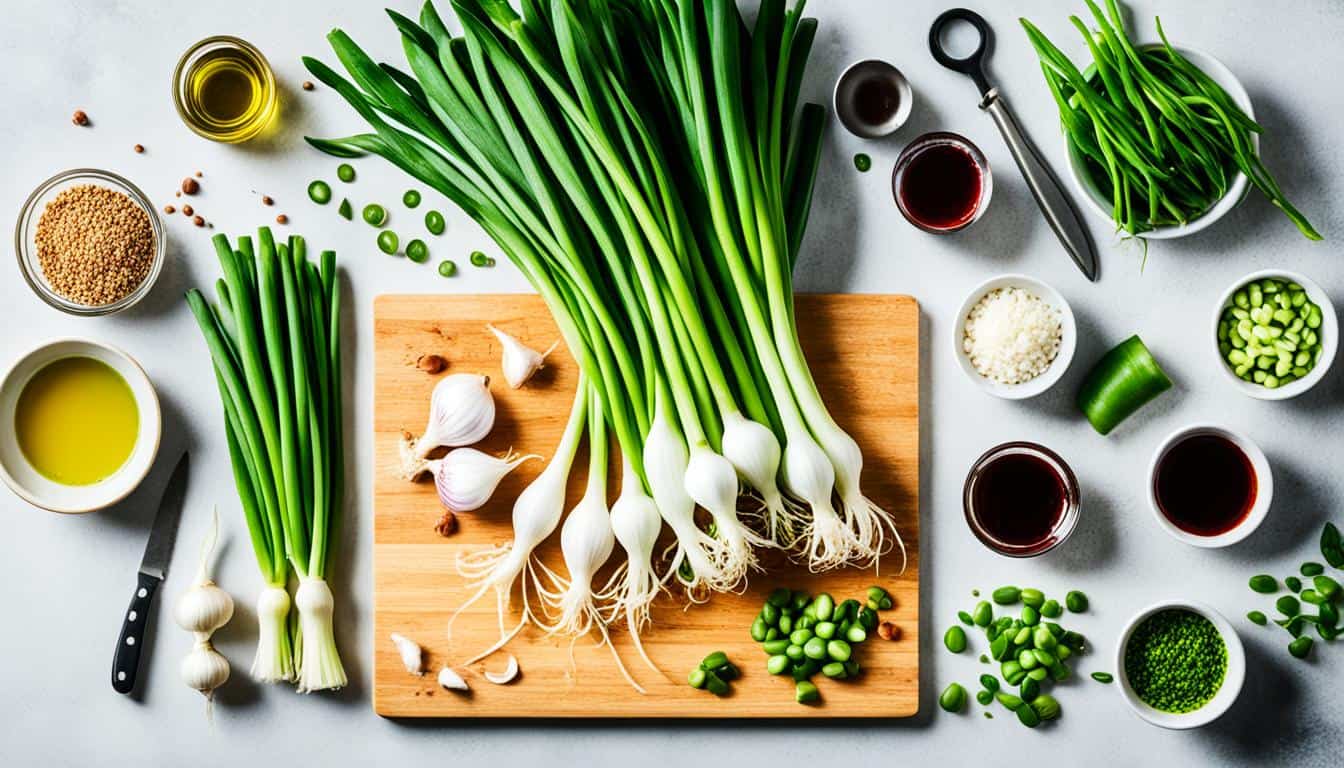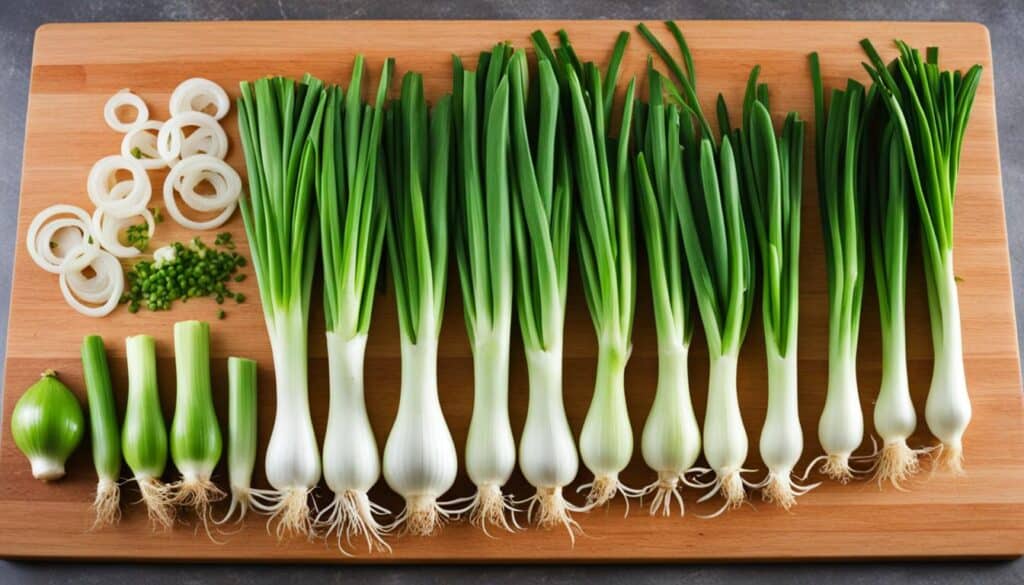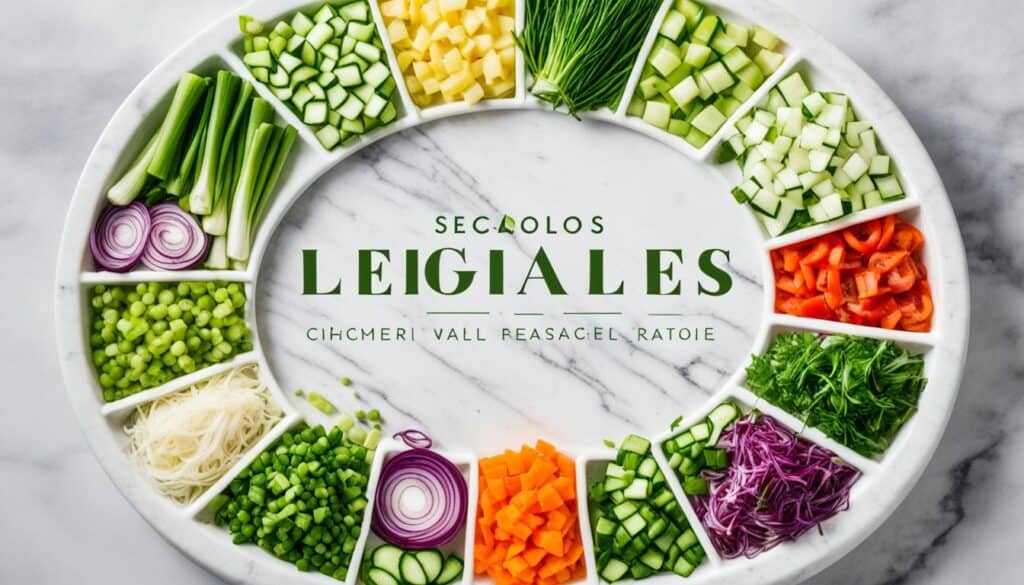Did you know that spring onions, also known as scallions or green onions, are not only delicious but also packed with health benefits? These versatile veggies are a staple in many culinary traditions and can elevate the flavor of any dish. Whether you’re a seasoned chef or an amateur cook, incorporating spring onions into your recipes is a great way to add a fresh and vibrant twist.
Key Takeaways:
- Spring onions, also known as scallions or green onions, are a versatile ingredient that can add a fresh and vibrant flavor to various dishes.
- Learning how to properly grow and chop spring onions is essential for utilizing them in your cooking.
- There are numerous delicious recipes that feature spring onions as a star ingredient.
- If you don’t have spring onions on hand, there are several substitutes available that can provide a similar flavor profile.
- Spring onions offer several health benefits due to their nutritional content, including vitamins and beneficial compounds.
What are Spring Onions, Green Onions, and Scallions?
Spring onions, green onions, and scallions are often used interchangeably in cooking, but they have slight variations in taste and appearance. Let’s explore the differences between these flavorful ingredients.
Spring Onions: Spring onions are baby onions with bulbs that have not fully developed. They have a mild, sweet, and savory flavor that adds a fresh and vibrant taste to dishes. Both the bulbs and the tops of spring onions can be used in cooking, making them a versatile ingredient in various cuisines. The bulbs are slightly larger compared to green onions or scallions, making spring onions a great choice for grilling, roasting, or adding a burst of flavor to salads and stir-fries.
Green Onions: Green onions are essentially young onions that have not fully matured. The tops of green onions are typically green and hollow, while the bulbs are small and white. Green onions offer a milder flavor compared to spring onions, making them a popular choice for garnishing soups, salads, and Asian dishes. They add a fresh and crisp element to recipes and are often enjoyed raw.
Scallions: Scallions, also known as green onions, are very similar to green onions in terms of taste and appearance. However, scallions are often harvested at a slightly earlier stage, resulting in a thinner bulb and more tender texture. Scallions are commonly used in Chinese, Korean, and Japanese cuisines, where they are used as a garnish or mixed into various dishes to enhance their flavor profiles.
While the terms may vary regionally, spring onions, green onions, and scallions exhibit small differences in taste and texture. Regardless of the name, these versatile vegetables can elevate the flavor of your culinary creations.
Quotes:
“Spring onions, green onions, and scallions are often used interchangeably in cooking, but they have slight variations in taste and appearance.” – Chef Emily
| Spring Onions | Green Onions | Scallions |
|---|---|---|
| Mild, sweet, and savory flavor | Milder flavor | Milder flavor |
| Bulbs are larger | Bulbs are small and white | Thinner bulbs, more tender texture |
| Used in grilling, roasting, and various dishes | Garnish for soups, salads, and Asian dishes | Garnish or mixed into various dishes |
How to Cook Spring Onions
When it comes to cooking with spring onions, the possibilities are endless! Whether you prefer them raw or cooked, these versatile vegetables can add a burst of flavor to any dish. In this section, I’ll share some cooking tips and techniques to help you make the most of spring onions in your culinary adventures.
Raw Delights
If you’re looking to enjoy the crisp texture and fresh taste of spring onions, incorporating them raw into your recipes is a fantastic option. Simply slice them thinly and add them to salads, sandwiches, or wraps for an extra crunch and tangy flavor. Their mild and subtle sweetness can complement various ingredients, making them a versatile addition to your favorite raw dishes.
Grilled Goodness
If you want to experiment with the flavors of spring onions, grilling them can elevate their taste to a whole new level. Start by trimming the roots and cutting the onions in half lengthwise. Brush them with a drizzle of olive oil to enhance their natural sweetness. You can then cook them on a grill, in the oven, or in a pan, depending on your preference. The cooking time will vary depending on the method used and the desired tenderness. Grilling or roasting spring onions adds a delicious smoky flavor that pairs well with BBQs, risotto, pasta, and even pizza!
Cooking Tips and Techniques
Here are some quick cooking tips to ensure your spring onions turn out perfect every time:
- Trim the roots and remove any damaged or slimy outer layers.
- Cut the onions in half lengthwise for even cooking.
- Consider brushing them with olive oil to prevent sticking and enhance the flavor.
- Experiment with different cooking methods like grilling, roasting, or sautéing to discover your favorite way to enjoy these tasty vegetables.
Now that you have some handy cooking tips, it’s time to unleash your creativity and make some delicious dishes with spring onions as the star of the show!
Next, let’s explore an array of mouthwatering spring onion recipes that will inspire your culinary adventures.
Spring Onion Recipes
There are numerous delicious recipes that feature spring onions as a star ingredient. From grilled asparagus and spring onions with lemon dressing to rhubarb, chrvre, and caramelized spring onion grilled cheese, there’s no shortage of creative ways to incorporate spring onions into your meals. Other recipes include creamed chard and spring onions, butter-braised spring onions with lots of chives, and deep-fried spring onions. Whether you’re looking for vegetarian options like vegan crispy duck lettuce wraps or non-veggie options like chicken and spring onion stir-fry, there’s a recipe to suit every taste.
Here are some mouthwatering spring onion recipes to inspire your culinary adventures:
- Grilled Asparagus and Spring Onions with Lemon Dressing: Combine the flavors of grilled asparagus and spring onions with a tangy lemon dressing for a refreshing side dish.
- Rhubarb, Chrvre, and Caramelized Spring Onion Grilled Cheese: Elevate your grilled cheese game by adding caramelized spring onions, rhubarb compote, and creamy chrvre cheese.
- Creamed Chard and Spring Onions: Create a creamy and flavorful side dish by simmering chard and spring onions in a rich cream sauce.
- Butter-Braised Spring Onions with Lots of Chives: Enjoy the delicate sweetness of butter-braised spring onions infused with aromatic chives.
- Deep-Fried Spring Onions: Crispy and addictive, deep-fried spring onions make a delicious snack or appetizer.
- Vegan Crispy Duck Lettuce Wraps: Replace traditional duck with marinated and stir-fried spring onions for a vegan-friendly twist on this popular dish.
- Chicken and Spring Onion Stir-Fry: Cook up a quick and flavorful chicken stir-fry with the addition of fresh spring onions for a burst of freshness.
No matter your dietary preferences or cooking skills, these spring onion recipes offer a wide range of options to satisfy your taste buds. Get creative in the kitchen and explore the versatile flavors of spring onions!
How to Chop Spring Onions
Properly chopping spring onions is essential for cooking with them effectively. Here’s a step-by-step guide to help you master the art of chopping spring onions:
-
Start by rinsing the onions under cool tap water. This will help remove any dirt or residue.
-
Next, remove any wilted or damaged tops and slimy skins from the onions.
-
Trim off the stringy root ends of the onions.
-
Cut about 2 inches from the green tops of the onions.
-
Depending on your recipe, you can slice the green onions thinly for garnishes or salads, cut them into 1-inch pieces for stir-fries, or julienne them for bite-size strips.
-
To finely chop spring onions, use a rocking motion with a chef’s knife. Start by holding the knife with one hand at the handle and the other hand on top of the blade. With a gentle rocking motion, move the knife back and forth, keeping the tip of the knife on the cutting board. Continue chopping until the pieces are small and uniform.
Now you’re ready to use your freshly chopped spring onions in your favorite recipes!
Tips for Chopping Spring Onions:
When selecting spring onions, choose ones with firm bulbs and fresh-looking tops.
Always use a sharp knife for chopping to ensure clean cuts and prevent bruising.
If you prefer a milder flavor, you can remove the white bulb portion and use only the green tops.
If the spring onions have a strong odor, you can soak them in cold water for a few minutes to reduce the pungency.
Chopping Spring Onions Table:
| Chopped Style | Recipe Uses |
|---|---|
| Sliced thinly | Salads, garnishes |
| 1-inch pieces | Stir-fries, soups, stews |
| Julienne | Stir-fries, Asian-inspired dishes |
| Finely chopped | Sauces, dressings, dips |
Growing Spring Onions
I always find it incredibly rewarding to grow my own produce, and spring onions are no exception. They are versatile, delicious, and can be easily grown at home. Whether you have a sprawling garden or just a small balcony, you can enjoy the satisfaction of harvesting your own fresh spring onions.
Planting Spring Onions
There are two ways to get started with growing spring onions: using seeds or the roots of other spring onions. If you opt for seeds, sow them in well-drained soil, about half an inch deep. Make sure to space the seeds about an inch apart to allow room for growth.
For those using the roots of other spring onions, simply leave about an inch of the white bulb attached to the roots and plant them in the soil.
In both cases, make sure to provide your spring onions with regular watering to keep the soil moist, but not waterlogged.
Optimal Conditions
Spring onions thrive in full sun to partial shade, so choose a spot in your garden or balcony that receives at least 4-6 hours of sunlight each day. This will ensure that your spring onions grow healthy and vibrant.
Harvesting Spring Onions
One of the best parts of growing spring onions is that you can start harvesting them in as little as 8 weeks. When your spring onions reach a height of about 6 inches, it’s time to harvest the green tops.
Using a pair of kitchen shears or a sharp knife, cut the green tops leaving about an inch above the soil. This allows for regrowth, ensuring a continuous supply of fresh spring onions.
Tips for Success
Here are a few additional tips to help you successfully grow spring onions:
- Water regularly to keep the soil moist, but avoid overwatering.
- Remove any weeds or competing plants around your spring onions to ensure they receive sufficient nutrients.
- If you notice any pests or diseases, take appropriate measures to protect your spring onions.
- Consider companion planting with other compatible vegetables or herbs to enhance growth and repel pests.
With proper care and a little patience, you’ll soon be enjoying a bountiful harvest of fresh, homegrown spring onions that will add a burst of flavor to your culinary creations.
| Advantages of Growing Spring Onions at Home | Disadvantages of Growing Spring Onions at Home |
|---|---|
| Control over pesticides and chemicals | Requires regular maintenance |
| Access to fresh produce without the need to purchase | Requires space and sunlight |
| Cost-effective compared to store-bought spring onions | Potential for pests and diseases |
| Opportunity for experimentation with different varieties | Seasonal limitations |
| Satisfaction of growing your own food | Patient wait for harvest |
Spring Onion Substitutes
If you don’t have spring onions on hand or prefer to use alternatives, there are several substitutes available. While not identical in taste, these options can provide a similar flavor profile. Some spring onion substitutes include red onions, shallots, leeks, and scallions. Red onions and shallots offer a stronger flavor, while leeks and scallions provide a milder taste. Experimenting with different substitutes can add unique flavors to your dishes and allow for customization based on personal preferences and availability.
| Spring Onion Substitute | Taste |
|---|---|
| Red Onions | Strong flavor |
| Shallots | Strong flavor |
| Leeks | Milder taste |
| Scallions | Milder taste |
Experiment with these spring onion substitutes to add unique flavors to your dishes. Depending on the recipe and your personal preferences, you can easily customize the taste by using red onions for a bold kick, shallots for a robust flavor, leeks for a subtle touch, or scallions for a mild taste. These substitutes can complement a wide range of dishes and provide a satisfying culinary experience.
Try these alternatives when spring onions are not available or to explore different flavors in your cooking. Whether you’re making stir-fries, salads, or soups, these substitutes can help you achieve the desired taste and aroma. Don’t be afraid to experiment and discover new combinations that enhance your culinary creations!
Health Benefits of Spring Onions
When it comes to incorporating healthy ingredients into your diet, spring onions are a delicious and nutritious option. These versatile vegetables offer numerous health benefits that can contribute to overall well-being.
Here are some of the key health benefits of spring onions:
- Rich in Vitamins: Spring onions are packed with essential vitamins, including vitamin C, vitamin K, and vitamin A. These vitamins play a crucial role in supporting various bodily functions, such as boosting immune function, promoting healthy skin, and supporting vision health.
- Antioxidant Properties: Spring onions contain beneficial compounds like quercetin and sulfur compounds, which act as antioxidants. These antioxidants help combat free radicals in the body, reducing oxidative stress and potentially lowering the risk of chronic diseases.
- Anti-inflammatory Effects: The sulfur compounds found in spring onions have anti-inflammatory properties. This means that consuming spring onions may help reduce inflammation in the body, which can contribute to improved heart health and a reduced risk of certain diseases.
- Heart-Healthy: The antioxidants and anti-inflammatory compounds in spring onions can have positive effects on heart health. They may help lower blood pressure, reduce cholesterol levels, and prevent the formation of blood clots, ultimately promoting a healthy cardiovascular system.
- Weight Management: If you’re watching your weight, incorporating spring onions into your meals can be a smart choice. These vegetables are low in calories and carbohydrates, making them a satisfying and nutritious addition to a balanced diet.
Disclaimer:
While spring onions offer several health benefits, it’s important to remember that individual results may vary. If you have any specific health concerns or medical conditions, it’s always a good idea to consult a healthcare professional before making significant changes to your diet.
| Health Benefit | Description |
|---|---|
| Vitamins | Spring onions are rich in essential vitamins, including vitamin C, vitamin K, and vitamin A, which support immune function, skin health, and vision. |
| Antioxidant Properties | Quercetin and sulfur compounds in spring onions act as antioxidants, fighting free radicals and reducing oxidative stress. |
| Anti-inflammatory Effects | Sulfur compounds in spring onions have anti-inflammatory properties, potentially benefiting heart health and reducing the risk of diseases. |
| Heart-Healthy | The antioxidants and anti-inflammatory compounds in spring onions can contribute to a healthy cardiovascular system by lowering blood pressure, reducing cholesterol levels, and preventing blood clot formation. |
| Weight Management | With their low calorie and carbohydrate content, spring onions can be a nutritious and satisfying addition to a balanced diet, supporting weight management. |
Incorporating spring onions into your meals not only adds flavor but also provides valuable health benefits. Whether you enjoy them raw in salads or cooked in a variety of dishes, spring onions can be a nutritious and delicious addition to your culinary repertoire.
Conclusion
Fresh spring onions are a culinary powerhouse that can take your dishes to the next level. Their unique flavor adds a refreshing twist to salads, stir-fries, and various other recipes. By mastering the art of cooking and chopping spring onions, you can fully unleash their potential in your kitchen.
Not only do spring onions offer a burst of flavor, but they also come with numerous health benefits. Packed with vitamins, antioxidants, and anti-inflammatory compounds, they can contribute to improved heart health, immune function, and digestion. Incorporating spring onions into your meals is an easy and delicious way to enhance both the taste and nutritional value of your dishes.
Whether you’re an experienced chef or just starting your culinary journey, exploring the world of fresh spring onion recipes opens up a whole new realm of possibilities. From vibrant salads to savory stir-fries, there’s a spring onion recipe to suit every palate. Experiment with these versatile greens, follow the cooking tips, and savor the amazing flavors they bring to your table. Fresh spring onions are a must-have ingredient that will elevate your cooking and nourish your body.









Leave a Reply